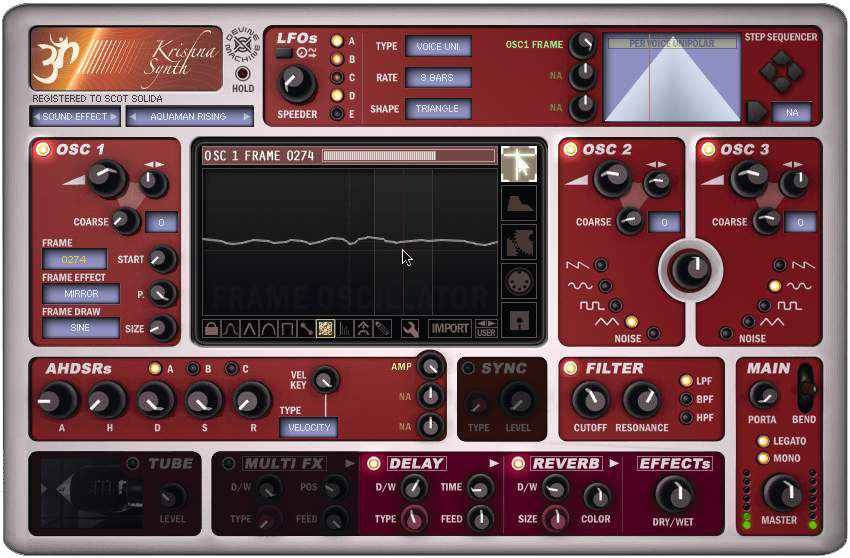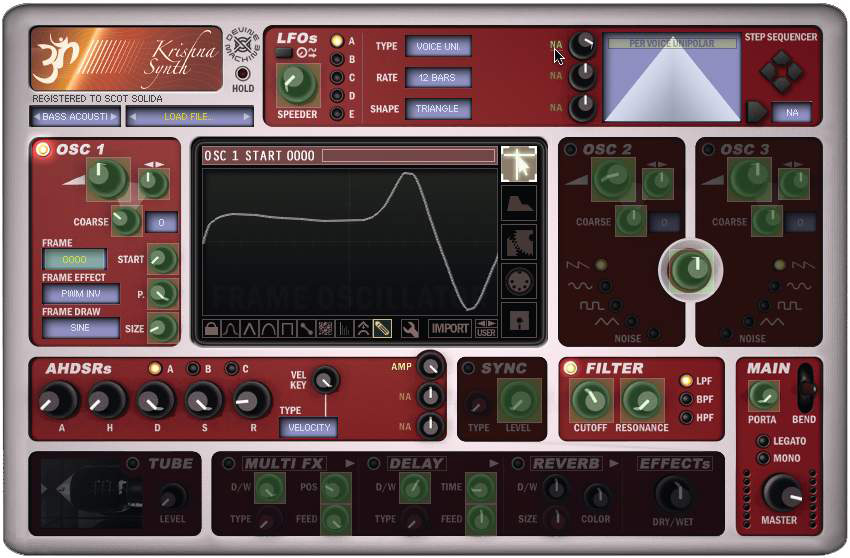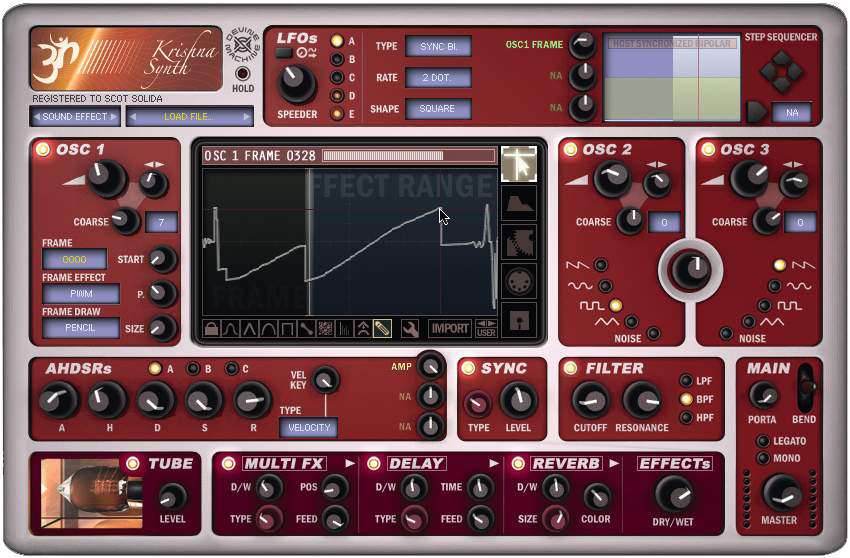MusicRadar Verdict
Avid synthesists and sound designers should get a kick out of Krishna Synth - and in particular its Frame Oscillator - though Mac users should wait for a more stable version.
Pros
- +
New and interesting. Frame Oscillator. Compact design. Excellent modulation tools. Monthly instalment plan.
Cons
- -
Big hard-drive footprint. Noise generator broken on the Mac. Import buggy on Mac.
MusicRadar's got your back

Devine Machine Krishna Synth

Devine Machine Krishna Synth

Devine Machine Krishna Synth
Not so long ago we were grousing about the dearth of new methods of synthesis, surrounded by ROMplers and virtual analogue synths, nothing more. It would seem our pleas have been answered in spades.
We've recently seen a wealth of synths released that shed the shackles of the commonplace in favour of more challenging and, most importantly, more inspiring instruments.
We have to confess that, while we definitely love our retro synths, we're always pleased when a developer deigns to design something that has no hardware, er, analogue.
Devine Machine's Krishna Synth is such an instrument.
While it isn't without precedent, it presents some unfamiliar ideas in an inviting (if not that intuitive) package that'll have you designing sounds you're unlikely to hear anywhere else.
Specifications
Krishna Synth is a cross-platform VST plug-in, with AU and RTAS formats on the way.
Though it isn't strictly a ROMpler, it comes with 3GB of data in the shape of well over a thousand presets, so lots of room on your hard drive is a must. The soul of Krishna Synth lies in its Frame Analysis Technology (or F.A.T.), with which a sample or sound may be converted to a series of many individual 'Frames'.
Said Frames are then stored as Krishna Movie Files, which can be played back using Oscillator 1 - the so-called Frame Oscillator.
A modulation source can be applied to the playback to 'animate' the proceedings. This is not unlike granular resynthesis or even PPG-styled wavetable scanning, but on a deeper level.
In use
Krishna Synth comes with more than 2000 Movie files covering a wide range of sounds, but the real power of the instrument becomes apparent when importing your own samples.
Any sound is fair game, though depending on your platform Krishna Synth seems a bit particular about where that sound should be located.
We froze Cubase 4 on our Mac when trying to import a sound. When we copied the sample into the Movies directory in the Krishna folder, we were able to convert it successfully.
Our Windows test machine had no such issues when we tried to do likewise on it.
Once you've selected or created a Movie file, you can perform all manner of manipulations.
There are a range of drawing tools for shaping a given Frame, as well as a few methods by which the number of Frames can be adjusted for a given sound.
Krishna Synth knows whether you're attempting to draw on a static or moving Frame and will adapt its behaviour accordingly.
In addition to the Pencil tool, you get Sine, Triangle and Ellipse tools, as well as a Line tool and a few others besides.
Directly manipulating Frames in this way is enjoyable and inspiring.
As mentioned, your Frames can be animated by a mod source, such as an LFO or AHDSR envelope.
This animation is not limited to linear playback either, so you could, with clever programming, twist a sample of the words "music radar" to something like "ramic dusar". Not that you'd want to. But you could.
Oscillator 1 is dedicated to the use of Frames, while Oscillators 2 and 3 offer traditional synthesis waveforms such as saw, square and sine waves.
There's also a noise generator, but on our Mac it produced not white noise, but only clicking static that played havoc with our meters.
Once again, this affliction was not shared by the Windows version.
The oscillators may be synced and can perform ring and frequency modulation duties, and all of them can be pumped through a simple multimode filter.
You get a choice of high-, low- or band-pass filters, as well as a single knob each for cutoff and resonance.
The modulation sources are represented by the aforementioned AHDSR envelope generators. There are three of 'em in tow and they're velocity sensitive.
Further modulation is provided by the five LFOs, each with 11 waveforms, as well as six LFO step sequencers. Oh, and there's a 16-step note sequencer with 128 memory slots.
Everything that should be syncable can indeed be synced to the host's tempo.
It goes without saying that there are built-in effects. All of the usual suspects are accounted for.
Reverb, delay, phaser, flanger and a tube emulator are here, and are slathered, as is usually the case, far too liberally over many of the presets.
Presets
As for presets, there are, as we said, 3GB of them. Many squeeze the best from the Frame Oscillator technology, while others are of the emulative sort (we prefer the former).
Some of the pads and effects are quite evocative, thanks to the Frame Oscillator's ever-changing animation.
The emulative sounds are less successful, though there are some excellent basses and leads onboard.
Due to the broken noise generator on the Mac version, some of the presets didn't play properly on that machine.
Summary
The path to enlightenment is often long and fraught with peril - Krishna Synth still has much of that journey ahead.
At this point, it offers a new and intriguing idea and is tightly designed.
Yet the developer undoubtedly has a few obstacles to overcome, particularly with the unstable Mac version.
However, intrepid sonic explorers who prefer the view through Windows will discover a powerful and engaging guide on the road to sonic nirvana.
With a reasonable pricetag (not to mention monthly instalment plans), Krishna could prove hard to resist.
Computer Music magazine is the world’s best selling publication dedicated solely to making great music with your Mac or PC computer. Each issue it brings its lucky readers the best in cutting-edge tutorials, need-to-know, expert software reviews and even all the tools you actually need to make great music today, courtesy of our legendary CM Plugin Suite.
“I called out to Mutt and said, ‘How about this?’... It was a complete fluke": How Def Leppard created a rock anthem - with a little bit of divine intervention
Baby Audio's Smooth Operator spectral balancing plugin goes pro
"It was ugly, like watching a divorce between four people. After a while, I had to get out": Beatles engineer Geoff Emerick on the recording of Abbey Road, track-by-track










